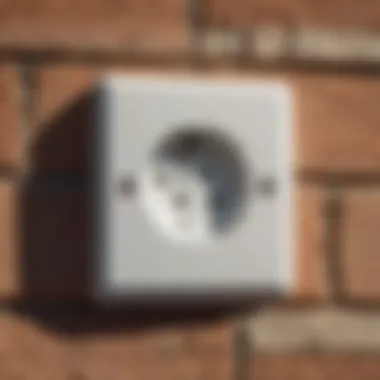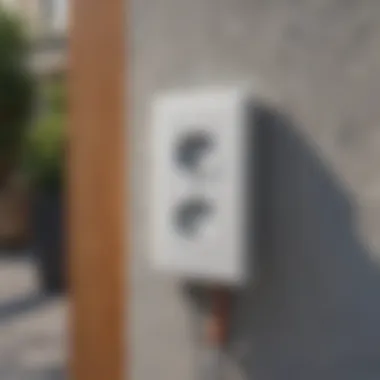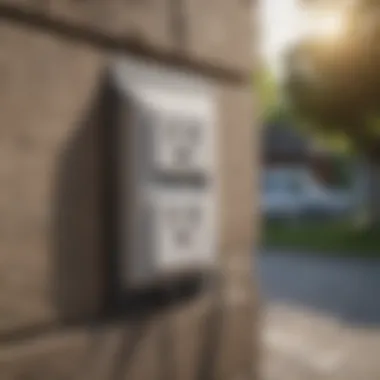Understanding Outdoor Outlets with Covers


Overview of Topic
When it comes to enhancing the functionality and safety of outdoor spaces, a well-establshed understanding of outdoor electrical outlets becomes a game changer. These outlets play a crucial role in allowing us to power a variety of outdoor devices, from holiday lights to garden tools, while ensuring that safety remains a top concern. They are specifically designed to withstand the elements and provide a reliable power source outside the walls of our homes.
The importance of outdoor outlets cannot be understated. They not only make life easier by providing electrical access in our yards, but they also minimize the risk of dangerous situations like electrical fires or shock incidents. The inclusion of protective covers brings another layer of safety, shielding the outlets from moisture, dirt, and debris, which can severely affect performance over time. Thus, understanding these systems is vital for all homeowners looking to boost their outdoor experiences without compromising on safety.
Common Challenges and Solutions
Despite their usefulness, many homeowners face specific challenges regarding outdoor outlets. Some of these include:
- Moisture Issues: Water exposure can lead to short circuits or, worse, electrocution.
- Inadequate Protection: Many older homes lack weatherproof outlets and covers.
- Complex Installation Processes: Not everyone has the skills or know-how to properly install outdoor outlets.
To navigate these hurdles, here are some practical solutions:
- Invest in Weatherproof Covers: Ensure the covers installed are rated for wet locations. Look for products with strong seals against moisture.
- Upgrade Older Outlets: Consider replacing outdated outlets with modern, GFCI (Ground Fault Circuit Interrupter) versions that offer better protection.
- Consult or Hire Professionals: If electrical tasks feel overwhelming, hiring a licensed electrician ensures everything is up to code and installed correctly.
Product Recommendations
When selecting outdoor outlets and covers, it’s key to understand the variety of products on the market and what sets them apart:
- Leviton Weather-Resistant Receptacle: This outlet is designed specifically for outdoor use, featuring moisture-tight gaskets and easy installation.
- Ceptic Waterproof Cover: Made of durable polycarbonate, this clear cover allows you to see the outlet while providing a robust barrier against rain and dirt.
- Square D GFCI Outlet: As a safety-first product, this outlet includes a ground fault circuit interrupter to quickly cut off power in the event of a fault.
Each of these options not only boasts standout features but also a reputation that homeowners can trust to safeguard outdoor electrical installations.
Step-by-Step Guides
Implementing outdoor outlets with covers involves a handful of key steps. Here’s a simple guide to follow:
- Determine Locations: Find suitable spots outside your home for new outlets based on your power needs.
- Check Local Codes: Always verify local building codes regarding electrical installations to ensure compliance.
- Gather Materials: Secure necessary tools and products including GFCI outlets, waterproof covers, extension cords, and connectors.
- Install Outlets:
- Add Protective Covers: Ensure your covers are installed to protect the outlets when not in use, following the manufacturer’s guidelines.
- Test Functionality: Once everything is in place, carefully restore power and test your outlets to ensure they work without issue.
- Turn off the power at the circuit breaker.
- Cut a hole for the new outlet, then follow instructions to install it securely in the wall.
- Connect all wires as per local electrical codes.
By following these directions, homeowners can enhance their outdoor spaces confidently, enjoying the benefits of electricity while ensuring every safety measure is accounted for.
"Electrical safety isn’t just aimed at preventing outages; it provides peace of mind for every homeowner."
Through this guide, we delve deeper into each of these sections to equip readers with useful insights that can simplify the sometimes overwhelming world of outdoor outlet installations.
Intro to Outdoor Electrical Needs
When it comes to utilizing outdoor spaces, having reliable electrical access is paramount. Outdoor outlets serve a variety of purposes, from powering tools during home renovations to illuminating pathways for evening gatherings. Understanding the significance of outdoor electrical needs not only enhances the overall functionality of your space but also contributes to the safety and enjoyment of outdoor activities.
The Role of Outdoor Outlets
Outdoor outlets are essential for a multitude of reasons. First and foremost, they provide convenient access to electricity without the need for long and unsafe extension cords. This alone reduces the risk of tripping hazards and potential accidents. Imagine prepping for a barbecue; with outdoor outlets, you can power your trusty electric grill or keep the drinks cool using an outdoor fridge. No more fumbling around with unsightly cords snaking across your yard.
Moreover, outdoor outlets enable you to enjoy the great outdoors without sacrificing modern conveniences. Whether it’s setting up festive lights for a summer evening or powering an electric lawn mower, the ease brought by outdoor outlets is undeniable. Having strategically placed outlets addresses practical needs while turning your yard into a functional extension of your home.
Importance of Electrical Safety Outdoor
Talking safety is vital when it comes to outdoor electrical installations. The outdoors comes with its own set of challenges—moisture, dirt, and unpredictable weather can wreak havoc on electrical systems. That's why understanding electrical safety regarding outdoor outlets is non-negotiable.
Using ground fault circuit interrupter (GFCI) outlets is one way to substantially reduce risks. These specialized outlets are designed to instantly cut off power if they detect any irregularities, such as water exposure or faulty wiring. This makes them a must-have for any outdoor electrical setup.
"Safety isn't expensive, it’s priceless."
By prioritizing electrical safety outdoors, homeowners can prevent not only property damage but potentially life-threatening situations. Regular checks and maintenance also ensure that your outdoor outlets function correctly and remain compliant with safety standards. The last thing you want is to host a lovely garden party, only to find out that your outlets are faulty.
Types of Outdoor Outlets
Understanding the different types of outdoor outlets is crucial for anyone looking to enhance their outdoor electrical functionality. An appropriately chosen outlet ensures that you have seamless access to power for various activities, be it lighting up your backyard for a gathering or plugging in a water fountain. Each outlet type comes equipped with distinct features and suitability, thus knowing the options can significantly enhance your outdoor experience. Let's break down the various types available to help you make an informed choice.
Standard Outdoor Receptacles
Standard outdoor receptacles are the most common type found in homes. These are designed to endure outdoor conditions and can accommodate regular plugs. Importantly, these outlets should feature covers to protect them from moisture and debris, as this greatly extends their lifespan. It's like putting an umbrella over your favorite chair during a rainy day; it keeps things dry and ready for use.
- Key Features:


- Typically rated for 15 to 20 amps
- Standard voltage of 120 volts
- Often comes with a weatherproof cover
When purchasing standard outdoor receptacles, make sure they comply with the National Electrical Code (NEC) requirements. This compliance is essential not only for safety but for ensuring durability. It's important to remember that once you install your outdoor receptacle, regular inspections can save you from future headaches.
GFCI Outlets
Ground Fault Circuit Interrupter (GFCI) outlets are a game changer, especially in wet areas where the risk of electric shock is higher. These outlets work by monitoring the current flowing through the circuit. If there's an imbalance—say, due to a short circuit or ground fault—the GFCI will cut off the electrical flow in a fraction of a second. Think of it as a safety net, ready to catch you just before you fall.
- Key Features:
- Designed to protect against electrical shock
- Can be reset after tripping
- Recommended for areas near pools, sinks, and outdoor appliances
For homeowners, GFCI outlets are not just beneficial; they are often required by nature of NEC regulations. Therefore, consider installing these outlets where water poses a risk. Your peace of mind is worth it, knowing that you've taken proactive steps for safety.
Weather-Resistant Outlets
Weather-resistant outlets take outdoor safety to the next level. Unlike standard receptacles, these are specifically engineered to handle extreme weather conditions, including rain, snow, and direct sunlight. They come equipped with seals and gaskets that prevent moisture accumulation, thus ensuring that the electrical components remain functional even in harsh environments.
- Key Features:
- Higher moisture protection rating (often rated for NEMA 3R or higher)
- Withstands temperature fluctuations
- Built-in protective barriers against dust and insects
In areas where weather could wreak havoc on standard outlets, investing in weather-resistant outlets makes all the sense. They are perfect if you're fond of gardening or love hosting barbecues, letting you worry less and enjoy more of your outdoor space.
"Choosing the right outdoor receptacle not only boosts functionality but also ensures a safe outdoor environment for family and friends."
In summary, the world of outdoor outlets is diverse, with standard, GFCI, and weather-resistant options available to cater to specific needs. Each type of outlet serves a purpose, and when combined with protective covers, they make your outdoor electrical experience safer and more enjoyable.
Understanding Outlet Covers
When it comes to outdoor electrical installations, the role of outlet covers cannot be overstated. They are not merely an accessory; they are an integral part of a comprehensive electrical safety strategy. Understanding the various types of outlet covers and their benefits is crucial for ensuring that your outdoor outlets remain functional without compromising safety.
Types of Covers
Flip Covers
Flip covers are among the simplest types of protective covers for outdoor outlets. These covers typically feature a hinged design, allowing homeowners to easily open and close them as needed. The main appeal of flip covers lies in their user-friendliness. You can access the outlet with a simple flick of the wrist, making it convenient for frequent use.
Additionally, flip covers are often weather-resistant, providing a barrier against rain or snow when not in use. This ease of access does come with a downside: if not securely closed, they could potentially let moisture in. On balance, they serve as a functional and practical option, especially for outlets in frequently used outdoor spaces, like patios or decks.
Weatherproof Covers
Weatherproof covers take the concept of protection a step further. Specifically designed to shield outlets from the elements, these covers are an essential choice if you live in an area known for severe weather conditions. One key characteristic of weatherproof covers is their robust construction, which often includes seals that prevent rain and snow from infiltrating the outlet.
While these covers offer an unbeatable layer of protection, they can sometimes require more effort to access the outlet. If you are someone who uses the outlets infrequently, this trade-off is often worth it for the enhanced safety they provide against water damage and electrical faults.
Lockable Covers
For those serious about security, lockable covers present an excellent choice. These covers can be securely fastened, keeping unwelcome hands away from your outdoor outlets. The primary appeal lies in their ability to prevent unauthorized access, particularly in areas where children or guests might linger.
However, the flip side to the security they offer is that accessing the outlet can be cumbersome. This makes lockable covers best suited for outlets you want to safeguard but don’t need frequent access. Additionally, they help in protecting against dust and debris when not in use, providing peace of mind and prolonged functionality.
Benefits of Using Covers
Using covers on outdoor outlets offers several noteworthy benefits.
- Protection from Elements: By shielding outlets from water, dust, and dirt, covers can significantly prolong the life of electrical outlets.
- Enhanced Safety: With covers in place, the risk of accidental electrocution due to moisture exposure is greatly minimized.
- Aesthetic Appeal: Many outlet covers come in various designs and colors, allowing you to choose one that complements your outdoor decor.
- Ease of Use: Depending on the type, many covers can be easily opened one-handed, making them practical for day-to-day operations.
Overall, understanding the different types of outlet covers and their benefits provides homeowners with the information they need to make smart choices for outdoor electrical outlets.
Installation Guidelines
When it comes to installing outdoor outlets with covers, having clear guidelines is crucial. Not only does this process ensure that the outlets are installed correctly, but it also significantly enhances safety and functionality. Proper installation helps to prevent hazardous situations like short circuits or electric shocks, which can arise from moisture entering the outlet. Moreover, following these guidelines ensures compliance with electrical codes, providing peace of mind knowing your setup meets required standards.
Planning the Location
Choosing the right location for your outdoor outlet can make all the difference. Consider high-traffic areas where you might use electrical devices outdoors, such as near patios or gardens. Also, think about the accessibility of the outlet for both use and maintenance. You should avoid placing outlets near water sources, which could lead to safety issues. Additionally, take note of the Sun’s angle throughout the day; positioning it where direct sunlight doesn't hit may extend the lifespan of the outlet and cover.


A few things to keep in mind:
- Keep outlets clear from any obstructions like furniture.
- Ensure the outlet is at least a foot off the ground to help mitigate moisture exposure.
Tools and Materials Needed
Getting started means gathering the necessary tools and materials for installation. The right equipment not only saves you time but also ensures a smoother process. Here’s what you generally need:
- Tools:
- Materials:
- Screwdriver (both flathead and Phillips)
- Drill with bits (for creating holes)
- Wire stripper (to prepare your electrical wires)
- Voltage tester (for checking electrical current)
- Outdoor-rated electrical boxes
- Weatherproof outlet covers
- GFCI or weather-resistant outlets (depending on your choice)
- Electrical wire (make sure it's rated for outdoor use)
Don't forget electrical tape and wire nuts for securing connections!
Step-by-Step Installation Process
Now that you’ve chosen the location and gathered your materials, it’s time to roll up your sleeves and get to work. Here’s a straightforward installation process:
- Turn Off Power: Start by switching off the power at your main circuit breaker to avoid any accidents.
- Prepare the Area: If you’re installing a new outlet, dig a trench if necessary, according to local codes, to bury the wire 18 inches deep.
- Installing the Electrical Box: Secure the electrical box to the structure where you want the outlet placed. Ensure it's level and positioned correctly.
- Run Wiring: Feed your outdoor-rated electrical wire through the electrical box and into the house. Be mindful to use appropriate wire for your needs.
- Make Connections: Strip the ends of the wires, and connect the black wire to the brass screw, the white wire to the silver screw, and the ground wire to the green screw. Use wire nuts to secure any splices.
- Attach the Outlet and Cover: Fit your GFCI or weather-resistant outlet into the box, and fasten it in place. Finally, attach the weatherproof cover.
- Restore Power: Go back to your circuit breaker and turn the power back on. Test the outlet with a voltage tester to ensure everything works as it should.
"A well-installed outdoor outlet can make summer barbecues and holiday lighting a breeze, ensuring your outdoor spaces are as functional as they are beautiful."
Following these steps allows you to harness the benefits of outdoor electrical outlets, ensuring they are safely and effectively installed for your convenience.
Maintenance and Care
Maintaining outdoor outlets with covers is not just a matter of aesthetics; it’s crucial for ensuring safety and functionality. Over time, weather elements, pests, and debris can take their toll on these devices. Keeping them in top shape not only prolongs their lifespan but also minimizes hazards such as electrical malfunctions or fire risks. Regular maintenance empowers homeowners to enjoy their outdoor spaces without worrying about potential electrical issues.
Routine Checks
One of the best ways to care for outdoor outlets is through regular inspections. Homeowners should consider checking their outlets at least twice a year—preferably in spring and autumn. When conducting these checks, here are some essential steps to follow:
- Visual Inspection: Look for any signs of wear, rust, or damage. Make sure that the cover doors open and close smoothly. If you spot anything unusual, it could be a sign that it needs to be repaired or replaced.
- Test the Outlets: After plugging in different devices, ensure they operate correctly. If an outlet seems dead or intermittent, this could signal a deeper issue, prompting further investigation.
- Check Connections: Loose or fraying wires can lead to dangerous situations. Make sure connections are tight and there’s no visible damage to the wiring inside the outlet.
By keeping a regular check, homeowners can avoid potential pitfalls and save themselves headaches down the line.
Cleaning and Debris Removal
Cleaning outdoor outlets may sound like simple housekeeping, but it’s a vital aspect of maintenance. Dust, snow, leaf debris, and even insects can accumulate over time, potentially obstructing outlet function. Here’s how to keep these areas clean:
- Clear Away Debris: Regularly remove leaves and dirt from around the outlet. A quick sweep can prevent larger issues from developing, such as moisture accumulating, which can lead to corrosion.
- Use a Damp Cloth: For more thorough cleaning, use a damp cloth to wipe the face of the outlet and the surrounding surfaces. Make sure to wring it out to avoid dripping excess water, as moisture can pose a risk to functionality.
- Consider Seasonal Preparations: Before winter sets in, do a deep clean of the outlet and cover. Ensure there is no trapped moisture that could freeze and cause damage. Similarly, remove any snow buildup around the outlet during winter months.
"Regular maintenance of outdoor outlets not only ensures their safe operation but also preserves the integrity of your outdoor electrical systems."
Incorporating these simple yet effective cleaning and maintenance habits can make a significant difference. Homeowners should view these tasks not merely as chores but as an essential part of enjoying a safe and functional outdoor environment.
Compliance with Safety Standards
Ensuring that outdoor electrical outlets comply with safety standards is not just a matter of legal obligation; it fundamentally concerns the well-being of your home and loved ones. Safety compliance allows for rigorous checks and balances, providing peace of mind. After all, no one wants to face the dire consequences of an electrical mishap.
Understanding NEC Guidelines
The National Electrical Code (NEC) serves as the benchmark for safe electrical design, installation, and inspection. This set of guidelines is the backbone of electrical safety in residential settings. The NEC outlines specific requirements regarding the installation of outdoor outlets, particularly focusing on ground fault circuit interrupter (GFCI) protection.
GFCI outlets are designed to automatically disconnect power when they sense a ground fault, which often occurs when water is present. Considering the unpredictable nature of outdoor environments, installing GFCI outlets is not merely a recommendation but a necessity.
Here are some key NEC guidelines for outdoor outlets:
- Minimum Depth and Protection: Outlets must be installed in weatherproof enclosures to protect against moisture and debris.
- Location Matters: Outlets should be placed at least 12 inches above ground level to prevent accidental flooding.
- Use of Covers: Weatherproof covers that can protect outlets even when they are in use are mandated, further bolstering safety.
Understanding and adhering to these guidelines significantly reduces the risk of electrical shock and fire hazards.
Local Code Considerations
It's crucial to note that local codes can sometimes differ from NEC recommendations. While the NEC offers a robust framework, local municipalities may have additional stipulations based on prevalent climates or specific community concerns.


To ensure compliance, consider the following local code aspects:
- Inspect Local Updates: Codes can evolve, reflecting new safety data or technological advancements.
- Consulting Professionals: When in doubt, hiring a local electrician familiar with codes can save not only time but also future headaches.
- Permits and Inspections: Always acquire the necessary permits; inspections ensure that installations are up to snuff.
Always remember, local regulations can vary widely, and it is beneficial to discuss compliance with a local expert to cover all bases.
In sum, understanding NEC guidelines and local codes is paramount in safeguarding your outdoor electrical installations. Ignoring these safety standards could lead to significant hazards for both you and your property.
Troubleshooting Common Issues
When it comes to outdoor electrical systems, the reliability of outlets can make a world of difference. Problems with outdoor outlets, unlike their indoor counterparts, can arise from various elements such as weather, wear and tear, or even improper installation. The importance of troubleshooting common issues cannot be overstated. Recognizing problems early allows for timely interventions, minimizing risks and preventing larger, costlier troubles down the line.
Identifying Power Failures
Imagine you’re trying to illuminate your backyard for an evening gathering, only to find the lights refusing to switch on. This scenario is more common than you might think and could be attributed to multiple causes. Power failures in outdoor outlets can happen due to various reasons, such as:
- Tripped Circuit Breaker: Outdoor outlets are often linked to GFCI breakers. If the ground fault circuit interrupter trips, the power supply cuts off to prevent shock.
- Weather-Related Issues: Heavy rains or snow can lead to moisture seeping into the outlet, causing a short circuit.
- Worn Out Outlets: Over time, wear and tear can cause poor connections or component failures in the outlet itself.
To identifya power failure, first check if other outlets in the vicinity are functioning. Next, look for any visible damage, like cracks or moisture—these can be telltale signs that something is off. You can also inspect circuit breakers in your electrical panel for any switches that are flipped into the "off" position. If it feels like you are chasing shadows with consistent power disruptions, it might be a sign to consider upgrading to more resilient outlets.
Damage Assessment and Repair
Once you've identified that an outlet is, indeed, the culprit, the next step involves damage assessment and repair. This process is crucial, as it not only restores functionality but also ensures safety. Here are the steps to go through:
- Visual Inspection: Start by examining the outlet for burn marks or corrosion. A damaged outlet can spark risk.
- Testing for Power: Use a multimeter to check if there’s voltage in the outlet. If no power is detected but the circuit breaker is fine, the outlet may be dead.
- Assessing Wiring Condition: Inspect the wires leading to the outlet. Any frayed or exposed wires should be replaced immediately.
If upon investigation you find serious damage, such as burn marks or structural flaws, it’s best to reach out to a licensed electrician. Attempting to repair a severely damaged outlet without the necessary skills could lead to more significant issues or hazards.
"Regular checks and immediate action on issues can save much more than money; they can save lives."
In summaries, addressing common issues with outdoor outlets is about ensuring safety and functionality. Knowing the red flags—like power failures and outlet damage—can help homeowners manage their outdoor electrical needs more effectively.
Future Trends in Outdoor Electrical Outlets
Staying updated with future trends in outdoor electrical outlets is vital as technology evolves and the needs of homeowners change. These trends not only underscore innovative ways to enhance convenience but also emphasize sustainability and safety in outdoor settings. As more homeowners invest in outdoor spaces, understanding these advancements equips individuals with the knowledge to effectively utilize outdoor electrical installations.
Smart Outlets and Automation
The rise of smart technology is transforming everyday living, and outdoor electrical outlets are no exception. Smart outlets allow users to control outdoor lighting, appliances, and even irrigation systems via smartphone apps or voice commands.
- Remote Control: With smart outlets, you can easily turn devices on and off from inside your home. Imagine having the ability to switch on your outdoor lights before you arrive home—it's like inviting yourself back in style!
- Energy Management: Many smart outlets come equipped with energy consumption tracking features. This means you can monitor your outdoor lighting and equipment usage, helping to reduce energy waste. This facet is particularly appealing to homeowners looking to keep utility bills down while keeping a close eye on their electricity consumption.
- Integration with Other Smart Systems: Smart outlets may work seamlessly with home automation systems, creating an interconnected home environment. Whether it be lone security cameras or the setup of a complete smart garden, this integration enhances the outdoor experience.
"Embracing smart technology in outdoor settings means embracing a brighter future—one where convenience meets efficiency."
Despite the appeal, it’s essential to ensure that these outlets are weatherproof and designed specifically for outdoor use, to avoid potential hazards.
Sustainability in Outdoor Wiring
Sustainability has become a buzzword among homeowners today, and outdoor electrical setups are beginning to reflect this trend. Focusing on sustainable solutions isn't just wise for the planet; it can also save you money in the long run.
- Solar Power: More and more outdoor outlets are designed to incorporate solar energy. Solar-powered outlets not only provide power for outdoor activities but do so without adding to your electricity bill. Plus, they reduce reliance on traditional power sources, which is a win for both the environment and your wallet.
- Durable Materials: The trend is also towards using materials that withstand harsh weather without degrading quickly. Outlets made from high-quality, recycled materials enhance the longevity of installations, aligning with sustainable practices. This means fewer repairs and replacements in the long run.
- Energy Efficient Appliances: Installing outdoor outlets that support energy-efficient appliances promotes eco-friendly practices. For example, energy-efficient garden lights or outdoor cooking appliances can greatly contribute to reducing overall energy consumption in your home.
As homeowners become more conscientious about their environmental impact, the shift towards sustainability in outdoor wiring will likely continue to grow. By integrating smart technology with sustainability, individuals can not only beautify their outdoor spaces but also contribute positively to the planet.
Epilogue
The conclusion serves as a critical wrap-up for our exploration into outdoor outlets with covers. This section isn't just a mere summary but an essential part of the article that reinforces the key points discussed. It's where readers can consolidate their understanding and appreciate the heightened importance of safety and functionality in outdoor electrical installations.
Recap of Key Points
To distill the main aspects covered, here are several vital points:
- Types of Outdoor Outlets: We’ve explored standard outdoor receptacles, GFCI outlets, and weather-resistant outlets, each of which plays a unique role in ensuring safety and usability.
- The Role of Outlet Covers: By using covers such as flip, weatherproof, and lockable types, one significantly mitigates weather-related hazards and accidental disconnections.
- Installation Guidelines: Proper planning and execution of the installation process is crucial for long-term functionality and adherence to safety standards.
- Maintenance Practices: Regular checks and cleaning can greatly enhance the performance and durability of outdoor outlets, prolonging their life.
- Future Trends: As technology evolves, the shift toward smart outlets and sustainable solutions signifies a promising future for outdoor electrical setups.
By keeping these points in mind, homeowners can ensure a safe outdoor environment that meets their electrical power needs effectively.
Final Thoughts on Safety and Functionality
Ultimately, the essence of this discussion circles back to the goals of safety and functionality. The landscape of outdoor electrical needs has evolved immensely, but the underlying principles remain. Protecting oneself and loved ones from electrical hazards is paramount. Investing in high-quality outlets and protective covers is not just a matter of convenience—it's a proactive measure against potential dangers.
On a practical level, safety extends beyond installation. It's about fostering a culture of regular maintenance and vigilance. Pays off not only in current utility but also in peace of mind. Always remember, being well-informed equips homeowners with the ability to navigate their outdoor electrical needs decisively and capably.
"Safety isn’t just about what you do; it’s about how you think and act in your domain."
This concluding section is vital, laying down a solid foundation for making enlightened and practical choices regarding outdoor electrical setups.







